|

|
| Affenpinscher |
Affenpinscher originated in Central Europe (Munich, Germany and France) where they were used as watchdogs.
They are usually black, but they also come in gray, silver, red, belge or black and tan. They are members of the toy group
and were AKC recognized in 1936.They range in size from 9 to 11½ inches tall at the shoulder and have an average
lifespan of 12 to 14 years. Patellar luxation, corneal ulcers, respiratory difficulties, patent ductus arteriosus
and open fontanel are sometimes seen in this breed.
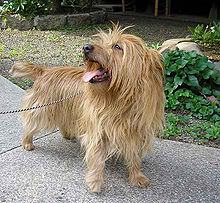
|
| Australian Terrier |
Australian Terrier was developed as a rodent & snake hunter in the rugged Australian Outback. They have
a blue and tan, sandy or red coat that is harsh in texture and are members of the terrier group and were AKC recognized in
1960.They are 10-11 inches tall at the shoulder and have an average lifespan of 12 to 14 years. Legg-Perthes disease,
cruciate ligament rupture, seizures, patellar luxation and diabetes are some of the health issues that are
foundinthis breed.
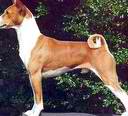
|
| Basenji |
Basenji is from Africa and is called the barkless dog. They were bred as hunters. Coat colors include chestnut
red, pure black or brindle -- all with white feet, chest and tail tip. They are member of the hound group and were AKC
recognized in 1944. Their ideal size ranges from 16 to 17 inches tall at the shoulder and 22 to 24 pounds. They have an average
lifespan of 12 to 14 years and may suffer from canine hip dysplasia, corneal dystrophy,patellar luxation,
progressive retinal atrophy, Fanconi syndrome, Basenji enteropathy, umbilical hernia, persistent pupillary membranes,
Pyruvate kinase deficiency, and hypothyroidism.

|
| Beagle |
Beagle from Englalnd and used to hunt rabbits. They comes in two height varieties (13 in. and 15 in.) and
any true hound color, including tri-color, red and white and lemon. They are members of the hound group and were AKC
recognized in 1885. The Beagle must be 15 inches tall or under and have an average lifespan of 12 to 15 years. Bealtes have
been know to be affected by patellar luxation, glaucoma, epilepsy, central progressive retinal atrophy, hypothyroidism, distichiasis,
chondrodysplasia, cherry eye, keratoconjunctivitis sicca, deafness, cataract, hemophilia A, demodicosis, umbilical
hernia , primary carnitine deficiency, and intervertebral disk disease.
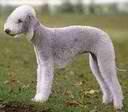
|
| Bedlington Terrier |
Bedlington Terrier is named for the Bedlington Mining Shire in the county of Northumberland, England, where
it was developed were they were used as rat hunters. Their coat starts out dark in puppyhood and fades to a pale bluish
gray, sandy or liver, giving him the appearance of a lamb. They are members of the terrier group and were AKC recognized
in 1886. They range in from 17 to 23 pounds in size. With an average lifespan of 12 to 14 years they are prone to copper
toxicosis,
renal cortical hypoplasia, retinal dysplasia, distichiasis. and the may suffer
frompatellar luxation.

|
| Bichon Frise |
Bichon Frise appeared as a descendent from the Water Spaniel and used as a companion dog. The coat must
be white, but may have shadings of buff, cream or apricot around the ears or on the body. They are members of the non sporting
group and were AKC recognized in 1972. Their ideal size between 9½ and 11½ inches tall at the shoulder. They have lifespan
of about 12 to 15 years and are prone to hyperadrenocorticism, allergies, patellar luation, cataract and canine hip dysplasia,
Legg-Perthes and liver disease.
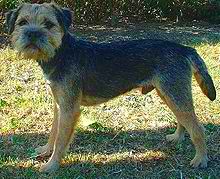
|
| Border Terrier |
Border Terrier originated in the border country between England and Scotland as fox hunters. They may
be red, grizzle and tan, blue and tan, or wheaten with a dark muzzle. They are members of the terrier group and were AKC
recognized in 1930. They range in size from 11½ to 15½ pounds. The Border Terrier has an average lifespan of 12 to 15
years and are prone to canine hip dysplasia, heart defects, and patellar luxation.
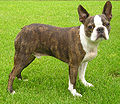
|
| Boston Terrier |
Boston Terrier was developed in the stables of Boston, Massachusetts, as a fighting dog. Their coat must
be black, brindle or seal with white markings. They are members of the non-sporting group and were AKC recognized in
1893. They are divided into classes by weight: Under 15 pounds; 15 pounds and under 20 pounds; 20 pounds and not to exceed
25 pounds. Boston Terrier have an averafe lifespan of 10 to 14 years and may suffer from he following health issues:stenotic
nares, allergies, elongated soft palate,patellar luxation, deafness, demodicosis, seizures, corneal abrasions, and cataract.

|
| Brussels Griffon |
Brussels Griffon, a watchdog, was developed in Belgium. They come in a variety of colors, including
red, belge (black and reddish brown), black and tan, or black. They are members of the toy group and were AKC
recognized in 1910. They range in size from 8 to 10 pounds and should not to exceed 12 pounds.
A Brussels Griffon has a very human expression and one was featured in 1997's hit, "As Good As It Gets", starring Jack
Nicholson and Helen Hunt. They have an average lifespan of 12 to 15 years. They may have some health issues like weak
bladder, distichiasis, patellar luxation, canine hip dysplasia, cataracts, and progressive retinal atrophy.
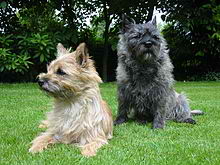
|
| Cairn Terrier |
Cairn Terrier originally bred to aid Scottish farmers in ridding their properties of pests. They come in be
any color except white. They are members of the terrier group and were AKC recognized in 1913. Their ideal size is about
10 inches tall at the shoulder and 14 pounds. "Toto" from the Wizard of Oz was a Cairn Terrier. They have an average
lifespan of 12 to 14 years and are prone to Globoid cell leukodystrophy, glaucoma, portacaval shunt, and Craniomandibular
osteopathy.

|
| Cardigan Welsh Corgi |
Cardigan Welsh Corgi first arrived in Cardiganshire (its place of origin) with the Celts in 1200 BC and
used as a drover and farm dog. Their coats colors include red, sable, brindle, black and blue merle. White markings are common.
They are members of the herding group and were AKC recognized in 1935.They range in size from 10.5 to 12.5 inches
tall at the shoulder and 25 to 38 pounds.
They have an average lifespan of 12 to 14 years and may suffer from degenerative myelopathy, canine
hip dysplasia, progressive retinal atrophy and urinary stones.

|
| Cavalier King Charles Spaniel |
Cavalier King Charles Spaniel were bred as a companion dog and descended from spaniel roots. They
come in four colors - Blenheim (chestnut and white), Tricolor (black, white, and tan), Ruby (solid red) and Black and Tan.
Thy are members of the toy group and were AKC recognized in 1995. There average size is 12 to 13 inches tall at
the shoulder and between 13 and 18 pounds. They have an average lifespan of 9 to 14 years and may be prone to patellar
luxation, entropion, syringomelia, mitral valve insufficiency,canine hip dysplasia, retinal dysplasia and reduced platelet
numbers.
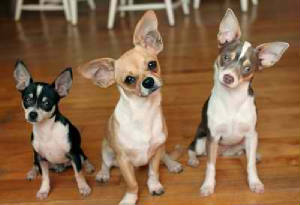
|
| Chihuahua |
Chihuahua has a mysterious history, earliest specimens of the breed were found in the Mexican State of Chihuahua.
They can be any color - solid, marked or splashed and the coat may be long or short. They are members of the toy group and
weigh under 6 pounds. They were AKC recognized in 1904. They have a life expectancy of about 15 or more years.They are prone
to rheumatism, slipped stifle, colds and gum problems, corneal dryness and secondary glaucoma, susceptible
to fractures, they have a tendency to wheeze and snore.
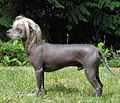
|
| Chinese Crested |
Chinese Crested are believed to have evolved from African hairless dogs and were used to hunt vermin on Chinese
ships. They come in two varieties: The Hairless and The Powderpuff and any color or combination of colors is allowed. They
are members of the toy group and were AKC recognized in 1991. Their ideal size is 11 to 13 inches tall at the shoulder.
They have an average lifespan of 13 to 15 years. They are prone to deafness, patellar luxation, seizures, progressive retinal
atrophy, lens luxation, glaucoma and occasionally Legg-Perthes.
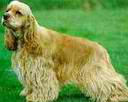
|
| Cocker Spaniel |
Cocker Spaniels comes in two varieties: the English Cocker Spaniel and the American Cocker Spaniel, both
can be traced back to England were they were used to hunt small game. Cocker Spaniels can be black, black with
tan points, parti-colored or any solid color.They are the smallest of the spaniels and the sporting group and were AKC recognized
in 1878 with an average size of 13 ½ inches to 15 ½ inches at the shoulder. They generally lives between 12 to 15 years.
Some health problems include progressive retinal atrophy, cataracts, patellar luxation, glaucoma, elbow dysplasia,
gastric torsion, epilepsy,cardiomyopathy, ectropion, urinary stones,otitis externa, canine hip dysplasia, hypothyroidism,
seborrhea, phosphofructokinase deficiency, entropion, "cherry eye," liver disease, allergies, and congestive heart failure
occiasionally affect this breed.
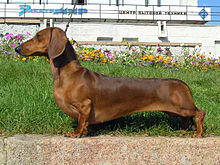
|
| Dachshund |
Dachshund the "badger dog" are from Germany. They come in three different coat varieties (Smooth, Wirehaired
or Longhaired) and can be miniature or standard size. Dachshund are members of the hound group and were AKC recognized
in 1885. Dachshunds can be standard or miniature size. The standards range from 16-32 pounds, while the miniatures weigh 11
pounds and under. They have an average lifespan of 12 to 14 years. They occasionally suffer from diabetes, gastric torsion,
deafness, seizures, patellar luxation, keratoconjunctivitis sicca and Cushing's diease. Intervertebral disk disease
is a major health concern. One-colored Dachshunds include red and cream; two-colored Dachshunds include black, chocolate,
wild boar, gray (blue) and fawn (Isabella); dapple (merle) pattern; brindle; and sable-the sable pattern.

|
| Dandie Dinmont Terrier |
Dandie Dinmont Terrier were bred as vermin hunters and first appeared near the border of England and
Scotland. They are members of the terrier group and were AKC recognized in 1886. They range in size from
8 to 11 inches tall at the shoulder and 18 to 24 pounds. Allowable coat colors are described as "pepper" and "mustard." They
have an average lifespan of 11 to 13 years and may suffer from cheyletiella mites infections, intervertebral disk disease
and glaucoma.
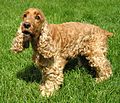
|
| English Cocker Spaniel |
English Cocker Spaniel descended from the original spaniels of Spain and used as hunting dogs. They are
members of the sporting group and were AKC recognized in 1946.They range in size from 15 to 17 inches tall at the shoulder
and 26 to 34 pounds and can be solid-colored (black, liver or shades of red) or parti-colored, including ticking or roaning
and generally has a lifespan of 12 to 14 years. Health-related problems may include patellar luxation, progressive retinal
atrophy,hypothyroidism, canine hip dysplasia, cataract, and kidney disease. The parti-colors are prone to deafness.

|
| English Toy Spaniel |
English Toy Spaniel originated in the Far East as a companion dog. This breed is divided into four varieties
based on color: Blenheim (rich mahogany red and white); ruby (rich mahogany red); Prince Charles (white with black and tan
markings); and King Charles (black and tan). They are members of the toy group and were AKC recognized in 1886.They range in
size from 8 to 14 pounds with an average lifespan of 10 to 12 years. They are susceptible to patellar luxation, early
tooth loss, and "lazy tongue."

|
| French Bulldog |
French Bulldog originated in Nottingham, England as lapdogs for lacemakers. They are indoor dogs that are
members of the non-sporting group and were AKC recognized in 1898. They must weigh 28 pounds or less and can be
brindle, fawn, white, and brindle and white. The French Bulldog ( Frenchies) have an average lifespan of 9 to 11 years.
Some health problems lnclude brachycephallic syndrome, intervertebral disk disease, allergies, and canine hip dysplasia,
patellar luxation, and hemivertebra. The French Bulldog is sensitive to heat and anesthesia, and dogs of this breed must be
delivered by Caesarean section.
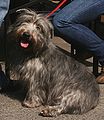
|
| Glen of Imaal Terrier |
Glen of Imaal Terrier is native to Ireland and bred to rid the home and farm of vermin,to hunt badger
and fox. They come in various shades of wheaten, blue and brindle. They are members of the terrier group and were AKC
recognized in 2004.They range from 12½ to 14 inches tall at the shoulder and have an average lifespan of 10 to 14 years.
Health problems may include canine hip dysplasia and progressive retinal atrophy.

|
| Havanese |
Havanese is a native of Cuba as a companion dog. They re members of the toy group and were AKC recognized
in 1996.They range in size from 8½ to 11½ inches tall at the shoulder and come in all colors. They should remain
untrimmed. The Havanese has an average lifespan of 12 to 14 years. Occasionally they may suffer from patellar luxation,
chondrodysplasia, elbow dysplasia, Legg-Perthes, portacaval shunt, deafness, and mitral valve insufficiency.

|
| Italian Greyhound |
Italian Greyhound pictures can be found in ancient decorative arts of the Mediterranean countries where
they were used a game hunters.. They are members of the toy group and were AKC recognized in 1886. They range from 13
to 15 inches tall at the shoulder and come in all colors,except brindle and classic black and tan. Italian Greyhound has
an average lifespan of 12 to 15 years.They are prone to patellar luxation, leg and tail fractures, epileps, progressive
retinal atrophy , and periodontial disese. They are sensitive to barbiturate anesthesia and susceptible to portacaval
shunt, Legg-Perthes, color dilution alopecia, cataract, andhypothyroidism on occasion.
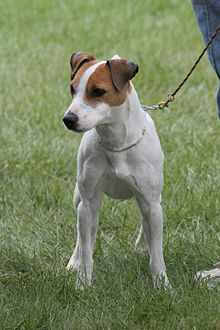
|
| Jack Russell Terrier |
Jack Russell Terrier are not recognized by the AKC. In the 1800's, the Reverend John "Jack" Russell created
a fox hound that would go into the dens and flush out the fox. There are three different Jack Russell Terrier
breeds, the Parson, the Russel ( which are both officially recognized by the AKC), and the Jack Russell, which)
isn't recognized. They range from 10 to 15 inches in height and 14 to 18 pounds. They may be prone
to dislocation of the kneecaps, inherited eye diseases, deafness and Legg Perthes—a disease of the hip joints of small
dog breeds. Prone to mast cell tumors. They have a life expectancy of about 15 or more
years.

|
| Japanese Chin |
Japanese Chin were bred as a companion dog in China. They are members of the toy group and were AKC recognized
in 1888. they range from 8 to 11 inches tall at the shoulder. Their coat can be either black and white, red and white,
or black and white with tan points. The Japanese Chin has an average lifespan of 10 to 12 years. They
are prone to ailments like patellar luxation, cataract, heart murmur, Keratoconjunctivitis Sicca, entropion, achondroplasia,
portacaval shunt, and epilepsy. They are also susceptible to corneal abrasions and cannot tolerate anesthesia
or heat.
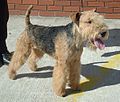
|
| Lakeland Terrier |
The Lakeland is an English breed originally developed by farmers to accompany them on hunts. They
come in a variety of colors including blue, black, liver, red and wheaten with or without a patch of color over the back and
shoulders called a "saddle" and are members of the terrier group. The were AKC recognized in 1934 and are approximately 14½
inches tall at the shoulder and 17 pounds. The Lakeland Terrier has an average lifespan of 12 to 16 years. They are
prone to lens luxation and distichiasis, Legg-Perthes disease and von Willebrand's Disease.
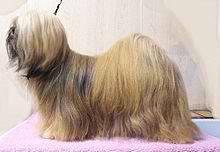
|
| Lhasa Apso |

|
| Lhasa Apso - clipped |
Lhasa Apso originating in Tibet and used an interior sentinel in the Buddhist monasteries. Lhasas come in
many colors from light blonde to black. The are member of the non sporrting group and were AKC recognized in 1935.
They range in size from 10 to 11 inches tall at the shoulder and 12 to 18 pounds.
The Lhasa Apso has an average lifespan of approximately 12 to 14 years. They are susceptible to patellar luxation, progressive
retinal atrophy, districhiasis, renal cortical hypoplasia, and entropion.

|
| Lowchen |
Lowchen originating in Pre-Renaissance Europe and used as an companion dog. All colors and color combinations
are acceptable and the range from 12 to 14 inches tall at the shoulder. The aer members of the non-sporting group and were
AKC recognized in 1996. The Löwchen has an average lifespan of 13 to 15 years.They may suffer from minor health problems like
patellar luxatin and they may be prone to serious heart conditions.
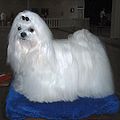
|
| Maltese |

|
| Maltese - clipped |
Maltese are from the island of Malta and used as a companion dog. They are members of
the toy group and were AKC recognized in 1888. They weigh under 7 pounds with 4 to 6 pounds being preferred and they
have a white coat. The Maltese has a lifespan of 12 to 14 years. They may suffer from deafness, shaker syndrome, dental problems,
patellar luxation, hydrocephalus, open fontanel, hypoglycemia, distichiasis, entropion, hypothyroidism, and portacaval shunt.

|
| Miniature American Eskimo Dog |
Miniature American Eskimo Dog descended from the European Spitzes and once used as a circus dog. They
hae nothing to do with the Eskimo culture. They are members of the non-sporting Group and were AKC recognized in 1994. They
are around 9 inches tall at the shoulder and are white and were originally referred to as the American Spitz. The
American Eskimo Dog has an average lifespan of about 12 to 14 years. They are susceptible to patellar luxation,
canine hip dysplasia, and progressive retinal atrophy, and occasionally diabetes.
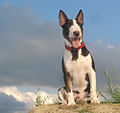
|
| Miniature Bull Terrier |
Miniature Bull Terrier descends directly from the Bull terrier. They are members of the terrier group
and were AKC recognized in 1991.They range in size from 10 to 14 inches tall at the shoulder and the coats can
be solid white or colored. The Miniature Bull Terrier has an average lifespan of 11 to 14 years. They may suffer from glaucoma,
lens luxation, deafness, and kidney disease.
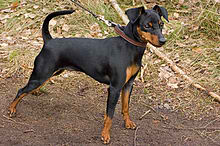
|
| Miniature Pinscher |
Miniature Pischer orginated in germany as a barnyard ratter. They are not miniature Dobermans. Their
coat colors include red, stag red (red with black hairs), black with rust markings, or chocolate with tan. They are members
of the toy group and were AKC recognized in 1925. They range from 10 to 12½ inches tall at the shoulder and have an
average lifespan of 12 to 14 yearsand is not meant for outdoor living. They may be prone to some health problems
like Legg-Perthes Disease, patellarluxatioon, hypothyroidism, Mucopolysaccharidoses VI, and
heart defects and Progressive Retinal Atrophy.
|
